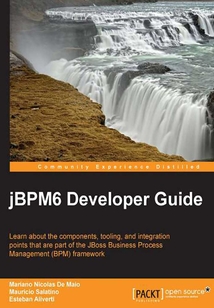舉報 

會員
jBPM6 Developer Guide
最新章節:
Index
IfyouareaJavadeveloperorarchitectwhoneedstohaveabetterunderstandingofhowBusinessProcessManagementframeworksbehaveinreal-lifeimplementations,thisbookisforyou.ThisbookassumesthatyouknowtheJavalanguagewellandarefamiliarwithsomewidelyusedframeworkssuchasHibernate.YoushouldalsoknowthebasicsofrelationaldatabasesandMaven-basedapplications.
目錄(78章)
倒序
- 封面
- 版權頁
- Credits
- About the Author
- Acknowledgments
- About the Author
- About the Author
- About the Reviewers
- www.PacktPub.com
- Support files eBooks discount offers and more
- Preface
- What this book covers
- What you need for this book
- Who this book is for
- Conventions
- Reader feedback
- Customer support
- Chapter 1. Why Do We Need Business Process Management?
- Theoretical background
- Introduction analysis and explanations of standard specifications
- Technical details and common practices of jBPM6
- The conceptual background of BPM
- The BPM discipline
- BPM applications in the real world
- Summary
- Chapter 2. BPM Systems' Structure
- Components of a BPMS
- Node instance structures
- External interactions
- Predictive analytics and decision management
- Summary
- Chapter 3. Using BPMN 2.0 to Model Business Scenarios
- Introduction to BPMN 2.0
- Modeling business scenarios with BPMN 2.0
- Technical perspective
- Summary
- Chapter 4. Understanding the KIE Workbench
- What you need to start a jBPM6 environment
- Summary
- Chapter 5. Creating a Process Project in the KIE Workbench
- An IDE to our knowledge
- Implementing our first process
- Sprint management process design
- The Web Process Designer advanced topics
- Providing a runtime for our process
- Summary
- Chapter 6. Human Interactions
- Understanding human interactions
- jBPM6 Human task component's overview
- Summary
- Chapter 7. Defining Your Environment with the Runtime Manager
- Understanding the role of the runtime manager
- The different implementations available
- The UI configuration of runtime managers
- Creating your own runtime manager
- Summary
- Chapter 8. Implementing Persistence and Transactions
- Why do we need persistence and transactions?
- Persistence in jBPM6
- Other persistence mechanisms
- Summary
- Chapter 9. Integration with Other Knowledge Definitions
- What is a rule?
- Old-fashioned integration
- The Drools rule engine
- Temporal reasoning and processes
- Summary
- Chapter 10. Integrating KIE Workbench with External Systems
- Defining your architecture
- Extending the KIE Workbench architecture
- Remote engine invocations
- Deploying the KIE Workbench in the cloud
- Summary
- Appendix A. The UberFire Framework
- UberFire
- Extending and reusing the UberFire UI components
- Summary
- Index 更新時間:2021-09-03 10:04:22
推薦閱讀
- Node.js+Webpack開發實戰
- Getting Started with Gulp(Second Edition)
- 玩轉Scratch少兒趣味編程
- React Native Cookbook
- C語言程序設計實訓教程
- Ray分布式機器學習:利用Ray進行大模型的數據處理、訓練、推理和部署
- C語言程序設計立體化案例教程
- Instant Debian:Build a Web Server
- HTML5+CSS3+JavaScript 從入門到項目實踐(超值版)
- Java程序設計教程
- Learning C++ by Creating Games with UE4
- JavaScript語法簡明手冊
- Learning GraphQL and Relay
- 移動智能系統測試原理與實踐
- 寫給所有人的編程思維
- Rust Quick Start Guide
- VB語言程序設計實驗教程
- Procedural Content Generation for Unity Game Development
- Xamarin Mobile Application Development for iOS
- Mastering the Nmap Scripting Engine
- Three.js開發指南
- 技術轉移:就這么干
- Learning OpenStack Networking
- Visual Basic 2008應用程序開發實例精講
- Learning BeagleBone Python Programming
- Haskell High Performance Programming
- Arduino: Building exciting LED based projects and espionage devices
- OpenJDK Cookbook
- GraphQL實戰:寫給全棧工程師們
- Learning Ceph(Second Edition)

